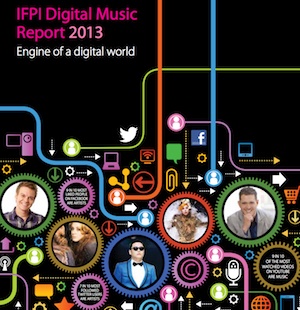
The IFPI (International Federation of the Phonographic Industry) released its annual Digital Music Report.
Report highlights:
- Global recorded music industry revenues increased by an estimated 0.3 percent in 2012, the first year of industry growth since 1999, to US $16.5 billion.
- Digital revenues increased by an estimated 9 percent to US $5.6 billion in 2012, now accounting for around 34 percent of global industry revenues.
- Download sales increased in volume by 12 percent globally in 2012 and represent around 70 percent of overall digital music revenues.
- The number of people paying to use subscription services leapt 44 percent in 2012 to 20 million. Subscription revenues are expected to account for more than 10 percent of digital revenues for the first time in 2012.
- Digital channels account for the majority of record companies’ income in an increasing number of markets including India, Norway, Sweden and the US.
- Digital retailers’ rapid global expansion is opening up the potential for markets such as Brazil and India, to become major sources of future industry growth. At the start of 2011, the major international services were present in 23 countries. Two years later, they are in more than 100 countries.
- Digital music consumption has become mainstream, as shown by consumer research by Ipsos MediaCT across nine markets in four continents. Two-thirds of internet users (62%) have used a licensed digital music service in the past six months. Among younger consumers (aged 16-24) this figure jumps to 81 percent.
- Consumer satisfaction with licensed music services is high. 77 percent of users of licensed services rate them as excellent, very good or fairly good. 57 percent of those who use unlicensed services believe “there are good services available for legally accessing digital music.”
- Many non-digital revenue channels are also increasing. Performance rights income increased in value by an estimated 9.2 percent in 2012 and now accounts for around 6 percent of overall industry revenues, up from 3 percent in 2007.
- The recording industry annually invests 26 percent of its trade revenues (U S$4.5 billion) in developing and marketing talent.
- IFPI estimates, based on data from Nielsen and ComScore, that as many as a third of all internet users (32%) still regularly access unlicensed sites.
- Advertising is a major source of funding for unlicensed music services worldwide. Major brands should no longer consider it acceptable to help fund illegal music sites.
- The music industry wants search engines to prioritize search results relating to licensed services. However, searches for the names of popular artists followed by the term “mp3” still return a large number of results for illegal sources on the first page.
- Internet service providers (ISPs) have had a demonstrable effect on levels of copyright infringement on the internet when required to act. For example, in five European countries where ISPs were required by courts to block access to The Pirate Bay (Netherlands, Belgium, Finland, Italy and UK), usage levels fell 69 percent during 2012 (ComScore/Nielsen). By contrast, in countries without the block, traffic rose by 45 per cent over the same period.

[fbcomments count="off" num="3" countmsg="Comments" width="100%"]

Category: Artist, Featured, Label, Organizations, Sales/Marketing
About the Author
Sarah Skates has worked in the music business for more than a decade and is a longtime contributor to MusicRow.View Author Profile



